Monitoring the acute effects of training load in soccer
Abstract
The purpose of the study was to analyze changes in enzymatic, psychometric and hematological variables during a microcycle of a pre-season in professional soccer, to verify which of these parameters are more sensitive to training loads. Eight male athletes were evaluated before training (M1) and after 14 sessions (M2). After testing the data normality, we performed a paired Student t-test to calculate differences between M1 and M2. In hematological markers, a decrease was observed in erythrocytes (p = 0.01), hemoglobin (p = 0.02) and hematocrit (p = 0.01). Relative to the enzyme, there was an increase of CK (p = 0.001) and LDH (p = 0.01). CK was the variable that best responded to the training load in the short-term, while the LDH, hematocrit, hemoglobin and erythrocytes were potential variables, which could help in understanding the CK responses in the monitoring of training, allowing its improvement.
Downloads
Metrics
• Authors retain the copyright and full publishing rights without restrictions.

This work is licensed under a Creative Commons Attribution 4.0 International License.









_1502.jpg)











